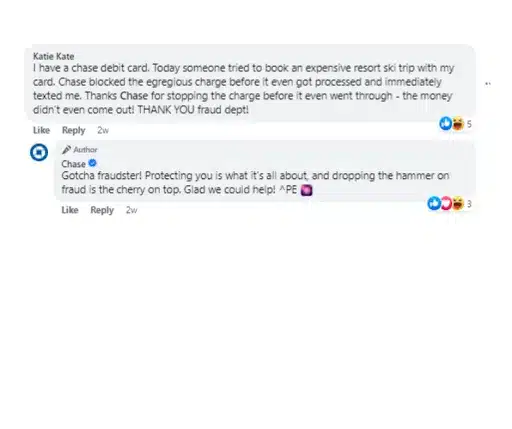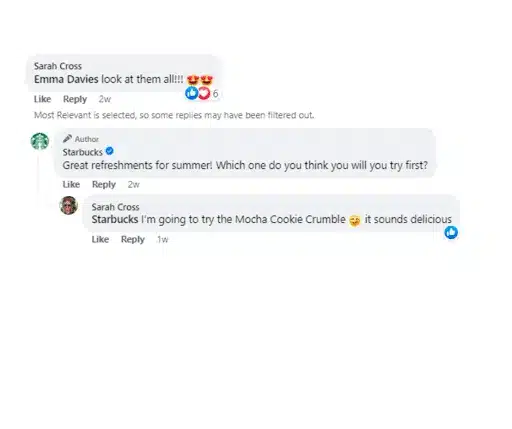45% of the world’s population is on at least one social media platform (Emarsys) and of those users, more than half post positive comments about the companies they interact with (TemplateLAB). Each of those positive comments on social media is an opportunity for a brand to build a loyal customer, manage their brand reputation on social media, and improve their online presence.
While many companies have guidelines for social media management that cover how to respond to negative comments, others don’t have any for positive ones. In this article, we’ll show you some creative ways to respond to positive comments on social media, as well as how to measure the impact of managing these comments.
Rebrand and resell AI-powered social media management software
Creative ways to respond to positive comments on social media
Instead of offering up a canned response to a positive customer comment, creative, individualized replies help users feel seen and heard. It can also help the brand build sales and long-term customer relationships. For example, customers who receive a personal response from a company they’ve reached out to on Twitter tend to spend as much as 20% more on future purchases (Twitter) and for most companies, that’s a significant difference.
How you respond to positive comments on social media should be guided by the brand’s voice and values above anything else. However, that doesn’t mean you can’t personalize your responses at least a little.
Use the following techniques as inspiration to craft unique social media replies and build a catalog of social media ideas for your business or your client’s business.
1. Use emojis, GIFs, and images
Adding visual flair to your responses has several benefits. While some see emojis as unprofessional in business, social media offers up the opportunity to communicate with customers on a more casual level. When it comes to emoji use in a professional setting, 91% of people say that emojis make communication easier, adding levity to conversations (Adobe).
A similar case can be made for using GIFs in your social media replies. Whether it’s laughter, appreciation, or happiness, GIFs are more likely to elicit an emotional response than a simple text reply and research demonstrates that these emotions are more likely to influence buying behaviors (Psychology Today).
Before responding to positive comments on social media with emojis, GIFs and images, take a moment to review your social media guidelines and ensure that the visuals you’re using align with the brand voice and values.
2. Send personalized private messages
Thank followers for their positive comments with a personalized private message. Make sure to use their name and acknowledge specifics from their comment to connect with them on a more personal level.
Personalized messages are a great way to build brand loyalty with followers and increase your client’s return on investment (ROI). In fact, 51% of brands that apply personalization across all touchpoints report achieving 300% or more ROI (Kibo Commerce).
3. Add humor to your responses
When done correctly, and if it’s on par with the brand’s identity and voice, adding humor when you respond to positive social media comments can elicit an emotional response from readers and strengthen brand recognition.
Only about 20% of brands are known for using humor in their social media marketing strategy. Meanwhile, 90% of consumers say they’re more likely to remember advertisements and brand interactions that made them laugh (Spiceworks).
Just remember to keep your responses appropriate for your audience. When you’re using humor, it’s easy to unintentionally cross a line so avoid humor that’s controversial, offensive, or gross.
Examples of positive comments on social media
Many brands go above and beyond when it comes to responding to positive comments on social media. Instead of a simple like or “thank you,” some brand will ask follow-up questions to engage with commenters and add humor with emojis and GIFs to create a positive and memorable reaction.
These brands make a lasting impression on customers, which helps showcase the brand’s personality and commitment to creating happy customers. While some brands, like Chase and Semrush, take a more witty approach to keep followers laughing, others, such as Starbucks, remain professional while offering up personalized, fun replies to their customers’ positive feedback.
Check out some examples of how these brands interact with their followers below.
Chase
Chase’s approach to social media is simple: speak to customers like you’re speaking to a friend.

This happy Chase client expressed their pleasure with Chase’s fraud detection services. Chase’s social media team crafted a response that garnered several reactions from followers, including laughter, with the use of casual, witty language and emojis.
Starbucks
Starbucks offers up plenty of great examples of how to respond to positive comments on social media. The company’s social media team has mastered the art of personalizing responses and asking questions to further engage the user who commented.

In this example, a user expressed excitement over the chain’s new summer beverages and tagged a friend, gaining exposure for the brand. Starbucks was quick to reply with a fun response, asking a follow-up question and thus, encouraging the user to post an additional reply. This technique heightens overall engagement and builds stronger customer relationships.
Semrush
Semrush does a great job of incorporating humor in its responses to positive social media comments without becoming offensive or making its followers uncomfortable.

In these responses to a fun post featuring a viral meme, the brand’s social media team took a playful approach in its replies.
How to measure the impact of responding to positive comments on social media
When you’re interacting with followers on any social media channel, it’s important to determine how well-received your comments and messages actually are. If you’re attempting to use humor or a more casual voice to respond to positive comments on social media, there is some risk of followers and other users responding negatively—or not responding at all.
When your engagement strategies don’t work the way they’re supposed to, you’ll need to revisit your approach and come up with different ways to respond to positive comments. But how can you tell? That’s where engagement metrics and analytics tools come in.
Engagement metrics
Engagement metrics guide brands through the vast social media landscape by helping them to gauge how their responses to positive comments on social media and other engagement strategies are performing. By analyzing metrics, you can effectively understand how well your interactions resonate with your client’s audience, giving you the insight you need to make informed decisions about your social media strategy.
Some key engagement metrics you’ll want to look at are highlighted below.
Response rate
Response rate is a fundamental metric that measures how quickly you or clients address comments on your social media channels. A high response rate indicates that you’re doing a good job of being proactive and monitoring for new comments. Conversely, a low response rate might leave your client’s customers feeling unheard or unimportant, which can ultimately affect engagement, follower counts, and ROI.
Sentiment analysis
Sentiment analysis is a qualitative metric that analyzes the way people talk about your brand across social media channels. It takes into account the positive comments on social media pages, along with negative comments and online reviews, to determine how consumers feel about your brand. Although it’s subjective, sentiment analysis can be useful in determining whether consumers perceive your responses to their comments as genuine, empathetic, enthusiastic, or artificial.
You can conduct a sentiment analysis manually or rely on automated tools that can detect key words and overall tone to determine how your audience feels.
Likes, shares, and comments
The most obvious engagement metrics you can monitor to determine whether your responses to positive comments on social media are serving you well are the brand’s likes, shares, and comments. When these numbers are high and continue to increase, it’s safe to assume that the audience is responding well to your interactions on social media. However, if you see a steady or sharp decline, head back to the drawing board and revisit your engagement strategy.
Brand mentions and hashtags
Utilize social listening tools to watch for brand mentions or hashtags related to the brand or its industry. When these mentions come up, review them and respond quickly when it makes sense. Analyze mentions and hashtags to determine if customers are sharing positive experiences and using brand-suggested hashtags or mentions. This positive, user-generated content indicates that word about the brand is spreading through organic advocacy.
Conversions and sales
Although conversions and sales aren’t necessarily a direct reflection of your responses to positive comments on social media, monitoring these numbers can help you analyze whether your overall strategy is working. If click-through rates, coupon code usage, website traffic, or sales have declined suddenly without explanation, it warrants a look at your social media etiquette and responses.
Analytics tools to measure your social media ROI
Monitoring and analyzing engagement metrics might sound overwhelming but thankfully, there are plenty of tools to help you get the job done quickly. From built-in analytics on social media platforms such as Google Business Profile, Facebook, and Instagram, to independent social listening tools, there are plenty of ways to quickly gather and review the metrics you need to gain valuable insights about your social media marketing efforts.
Solutions such as Vendasta’s Social Marketing tool can help you post, monitor comments and brand mentions, and track engagement metrics all in one place. This helps ensure you’re quick to provide a response to positive comments on social media platforms such as Facebook, Twitter, Instagram, LinkedIn, and Google Business Profile.
Alternatively, white-label social media management can take even more work off your plate as Vendasta’s social media experts handle everything from content creation and posting to social media analytics.
Final tips for engaging with audiences on social media
No matter what type of comment you’ll come across, learn to adopt these principles in every interaction with social media followers to maintain effective campaigns and ensure a positive brand reputation.
1. Be authentic
Authenticity is the cornerstone of social media engagement. Be genuine when you respond to positive comments on social media. Avoid generic replies and provide follower with personalized interactions that showcase the brand’s personality. This approach can help your client establish genuine connections with their audience, as well as build trust and leave a lasting positive impression.
2. Be personable
Social media exists to foster human connection so be personable when you’re responding to positive (or negative) comments. Use a conversational tone that’s reflective of the brand’s voice and when possible, address commenters by name. For most brands, social media offers the opportunity to engage with consumers on a more casual level so don’t be afraid to make responses fun or witty if it makes sense.
By being personable, you can show consumers that the brand is approachable, relatable, and inviting, which ultimately encourages further engagement and loyalty to the brand.
3. Be respectful to your audience
Regardless of the nature of the comment your responding to, respect should be at the core of your interaction. Always treat your audience with respect. While humor or wit might be acceptable in some situations (depending on brand voice), sarcasm and disrespect are never okay. Avoid using offensive language or making dismissive remarks in response to negative, neutral, or positive comments on social media.
4. Show gratitude
Without social media followers, you wouldn’t have the job you do. Keep that in mind when engaging with your followers or your clients’ audiences. Express gratitude in your responses by taking a moment to thank them for their comments and acknowledging their kind words.
By showing gratitude, your relationship with your audience strengthens and best of all, you’re encouraging the commenter and other followers to continue sharing positive experiences and advocating for your brand.


